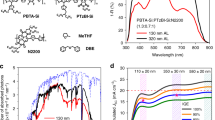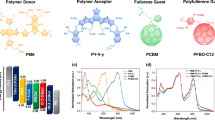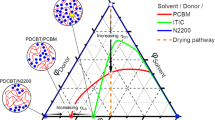Abstract
Improving the power conversion efficiency of polymer-based bulk-heterojunction solar cells is a critical issue. Here, we show that high efficiencies of ∼10% can be obtained using the crystalline polymer PNTz4T in single-junction inverted cells with a thick active layer having a thickness of ∼300 nm. The improved performance is probably due to the large population of polymer crystallites with a face-on orientation and the ‘favourable’ distribution of edge-on and face-on crystallites along the film thickness (revealed by in-depth studies of the blend films using grazing-incidence wide-angle X-ray diffraction), which results in a reduction in charge recombination and efficient charge transport. These results underscore the great promise of polymer solar cells and raise the hope of achieving even higher efficiencies by means of materials development and control of molecular ordering.
This is a preview of subscription content, access via your institution
Access options
Subscribe to this journal
Receive 12 print issues and online access
$209.00 per year
only $17.42 per issue
Buy this article
- Purchase on Springer Link
- Instant access to full article PDF
Prices may be subject to local taxes which are calculated during checkout




Similar content being viewed by others
References
Yu, G., Gao, J., Hummelen, J. C., Wudl, F. & Heeger, A. J. Polymer photovoltaic cells: enhanced efficiencies via a network of internal donor–acceptor heterojunctions. Science 270, 1789–1791 (1995).
Günes, S., Neugebauer, H. & Sariciftci, N. S. Conjugated polymer-based organic solar cells. Chem. Rev. 107, 1324–1338 (2007).
Brabec, C., Dyakonov, V. & Scherf, U. Organic Photovoltaics: Materials, Device Physics, and Manufacturing Technologies (Wiley-VCH, 2008).
He, Z. et al. Enhanced power-conversion efficiency in polymer solar cells using an inverted device structure. Nature Photon. 6, 591–595 (2012).
Ye, L., Zhang, S., Zhao, W., Yao, H. & Hou, J. Highly efficient 2D-conjugated benzodithiophene-based photovoltaic polymer with linear alkylthio side chain. Chem. Mater. 26, 3603–3605 (2014).
Liao, S.-H. et al. Single junction inverted polymer solar cell reaching power conversion efficiency 10.31% by employing dual-doped zinc oxide nano-film as cathode interlayer. Sci. Rep. 4, 6813 (2014).
Liu, Y. et al. Aggregation and morphology control enables multiple cases of high-efficiency polymer solar cells. Nature Commun. 5, 5293 (2014).
You, J. et al. A polymer tandem solar cell with 10.6% power conversion efficiency. Nature Commun. 4, 1446 (2013).
You, J. et al. 10.2% power conversion efficiency polymer tandem solar cells consisting of two identical sub-cells. Adv. Mater. 25, 3973–3978 (2013).
Scharber, M. C. et al. Design rules for donors in bulk-heterojunction solar cells—towards 10% energy-conversion efficiency. Adv. Mater. 18, 789–794 (2006).
Facchetti, A. π-Conjugated polymers for organic electronics and photovoltaic cell applications. Chem. Mater. 23, 733–758 (2011).
Boudreault, P.-L. T., Najari, A. & Leclerc, M. Processable low-bandgap polymers for photovoltaic applications. Chem. Mater. 23, 456–469 (2011).
Beaujuge, P. M. & Fréchet, J. M. J. Molecular design and ordering effects in π-functional materials for transistor and solar cell applications. J. Am. Chem. Soc. 133, 20009–20029 (2011).
Mühlbacher, D. et al. High photovoltaic performance of a low-bandgap polymer. Adv. Mater. 18, 2884–2889 (2006).
Peet, J. et al. Efficiency enhancement in low-bandgap polymer solar cells by processing with alkane dithiols. Nature Mater. 6, 497–500 (2007).
Blouin, N. et al. Toward a rational design of poly(2, 7-carbazole) derivatives for solar cells. J. Am. Chem. Soc. 130, 732–742 (2008).
Park, S. H. et al. Bulk heterojunction solar cells with internal quantum efficiency approaching 100%. Nature Photon. 3, 297–302 (2009).
Liang, Y. et al. Development of new semiconducting polymers for high performance solar cells. J. Am. Chem. Soc. 131, 56–57 (2009).
Liang, Y. et al. Highly efficient solar cell polymers developed via fine-tuning of structural and electronic properties. J. Am. Chem. Soc. 131, 7792–7799 (2009).
Liang, Y. et al. For the bright future—bulk heterojunction polymer solar cells with power conversion efficiency of 7.4%. Adv. Mater. 22, E135–E138 (2010).
Mataka, S. et al. Sulfur nitride in organic chemsitry. XIV, Selective formation of benzo-and benzobis[1, 2, 5]thiadiazole skeleton in the reaction of tetrasulfur tetranitride with naphthalenols and related compounds. Bull. Chem. Soc. Jpn 64, 68–73 (1991).
Wang, M. et al. A donor–acceptor conjugated polymer based on naphtho[1,2-c:5,6-c]bis[1,2,5]thiadiazole for high performance polymer solar cells. J. Am. Chem. Soc. 133, 9638–9641 (2011).
Osaka, I. et al. Synthesis, characterization, and transistor and solar cell applications of a naphthobisthiadiazole-based semiconducting polymer. J. Am. Chem. Soc. 134, 3498–3507 (2012).
Szarko, J. M. et al. When function follows form: effects of donor copolymer side chains on film morphology and BHJ solar cell performance. Adv. Mater. 22, 5468–5472 (2010).
Guo, X. et al. Bithiopheneimide–dithienosilole/dithienogermole copolymers for efficient solar cells: information from structure–property–device performance correlations and comparison to thieno[3,4-c]pyrrole-4,6-dione analogues. J. Am. Chem. Soc. 134, 18427–18439 (2012).
Peet, J. et al. Bulk heterojunction solar cells with thick active layers and high fill factors enabled by a bithiophene-co-thiazolothiazole push–pull copolymer. Appl. Phys. Lett. 98, 043301 (2011).
Price, S. C., Stuart, A. C., Yang, L., Zhou, H. & You, W. Fluorine substituted conjugated polymer of medium band gap yields 7% efficiency in polymer–fullerene solar cells. J. Am. Chem. Soc. 133, 4625–4631 (2011).
Li, W. et al. Efficient small bandgap polymer solar cells with high fill factors for 300 nm thick films. Adv. Mater. 3182–3186 (2013).
Osaka, I., Kakara, T., Takemura, N., Koganezawa, T. & Takimiya, K. Naphthodithiophene–naphthobisthiadiazole copolymers for solar cells: alkylation drives the polymer backbone flat and promotes efficiency. J. Am. Chem. Soc. 135, 8834–8837 (2013).
Osaka, I., Saito, M., Koganezawa, T. & Takimiya, K. Thiophene–thiazolothiazole copolymers: significant impact of side chain composition on backbone orientation and solar cell performances. Adv. Mater. 26, 331–338 (2014).
Xu, Z. et al. Vertical phase separation in poly(3-hexylthiophene): fullerene derivative blends and its advantage for inverted structure solar cells. Adv. Funct. Mater. 19, 1227–1234 (2009).
Guo, X. et al. Polymer solar cells with enhanced fill factors. Nature Photon. 7, 825–833 (2013).
Stuart, A. C. et al. Fluorine substituents reduce charge recombination and drive structure and morphology development in polymer solar cells. J. Am. Chem. Soc. 135, 1806–1815 (2013).
Sirringhaus, H., Brown, P., Friend, R. & Nielsen, M. Two-dimensional charge transport in self-organized, high-mobility conjugated polymers. Nature 401, 685–688 (1999).
Baker, J. L. et al. Quantification of thin film crystallographic orientation using X-ray diffraction with an area detector. Langmuir 26, 9146–9151 (2010).
Rivnay, J., Mannsfeld, S. C. B., Miller, C. E., Salleo, A. & Toney, M. F. Quantitative determination of organic semiconductor microstructure from the molecular to device scale. Chem. Rev. 112, 5488–5519 (2012).
Umeda, T., Kumaki, D. & Tokito, S. Surface-energy-dependent field-effect mobilities up to 1 cm2/Vs for polymer thin-film transistor. J. Appl. Phys. 105, 024516 (2009).
Kline, R., McGehee, M. & Toney, M. Highly oriented crystals at the buried interface in polythiophene thin film transistors. Nature Mater. 5, 222–228 (2006).
Duong, D. T., Toney, M. F. & Salleo, A. Role of confinement and aggregation in charge transport in semicrystalline polythiophene thin films. Phys. Rev. B 86, 205205 (2012).
Shrotriya, V., Yao, Y., Li, G. & Yang, Y. Effect of self-organization in polymer/fullerene bulk heterojunctions on solar cell performance. Appl. Phys. Lett. 89, 063505 (2006).
Acknowledgements
This research was supported by Grants-in-Aid for Scientific Research from The Ministry of Education, Culture, Sports, Science and Technology (MEXT) (nos. 24685030 and 23245041) and by Precursory Research for Embryonic Science and Technology from the Japan Science and Technology Agency. This work was partly supported by the Nanotechnology Platform Program of MEXT. Two-dimensional GIWAXD experiments were performed at SPring-8 with the approval of the Japan Synchrotron Radiation Research Institute (JASRI, proposal no. 2014A1530). The authors thank K. Tajima of CEMS, RIKEN, for helpful discussions regarding the fabrication of inverted cells and for the contact angle measurement, and K. Higashimine of the Center for Nano Materials and Technology, JAIST, for the EDS measurements. The authors thank Y. Hishikawa of the National Institute of Advanced Industrial Science and Technology (AIST) and H. Tobita of Japan Electrical Safety & Environment Technology Laboratories (JET) for technical discussions about the J–V measurements. The authors also thank Y. Hishikawa and A. Sasaki for measurement of the cell active area.
Author information
Authors and Affiliations
Contributions
K.K. prepared the polymer sample. V.V. and I.O. conceived and designed the solar cell experiments. V.V. and K.K. fabricated the conventional cells and K.K. and T.Ka. fabricated the inverted cells. I.O. and T.Ko. conceived and designed the GIWAXD experiments, and K.K. and T.Ko. conducted them. V.V., K.K. and I.O. prepared the manuscript, and all authors discussed and commented on the manuscript. V.V., I.O., K.T. and H.M. directed the project.
Corresponding authors
Ethics declarations
Competing interests
The authors declare no competing financial interests.
Supplementary information
Supplementary information
Supplementary information (PDF 3422 kb)
Rights and permissions
About this article
Cite this article
Vohra, V., Kawashima, K., Kakara, T. et al. Efficient inverted polymer solar cells employing favourable molecular orientation. Nature Photon 9, 403–408 (2015). https://doi.org/10.1038/nphoton.2015.84
Received:
Accepted:
Published:
Issue Date:
DOI: https://doi.org/10.1038/nphoton.2015.84
This article is cited by
-
Operando ESR observation in thermally activated delayed fluorescent organic light-emitting diodes
Scientific Reports (2023)
-
Integration of body-mounted ultrasoft organic solar cell on cyborg insects with intact mobility
npj Flexible Electronics (2022)
-
Enhanced efficiency of inverted organic solar cells by using alcohol molecules modified ZnO as an electron transport layer
Applied Physics A (2022)
-
A guest-assisted molecular-organization approach for >17% efficiency organic solar cells using environmentally friendly solvents
Nature Energy (2021)
-
Self-powered ultraflexible photonic skin for continuous bio-signal detection via air-operation-stable polymer light-emitting diodes
Nature Communications (2021)



